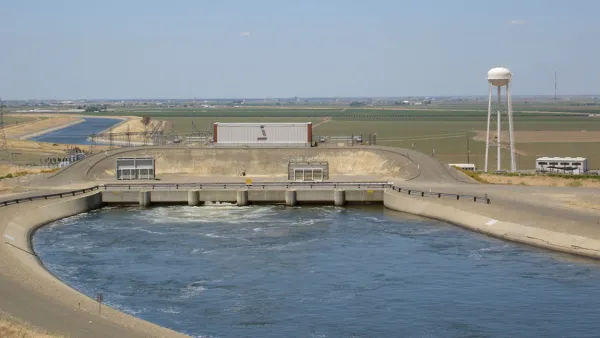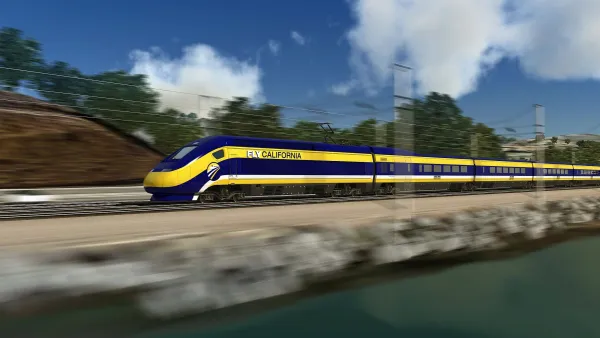'Huge' is an understatement. Revenues were less than 2 percent of what was forecasted. The uncertainty of the continuance of the program may be responsible. The plummet in revenues to high-speed rail adds to uncertainty of the $64 billion project.
The nation's only cap-and-trade program run by a state suffered an unanticipated setback when insufficient buyers purchased carbon allowances at the quarterly auction this month.
"The results of last week’s quarterly auction were posted [PDF] and revealed that instead of the $500-plus million expected from the sale of state-owned allowances, the state will get only about $10 million, less than 2 percent," writes Dan Walters, columnist for The Sacramento Bee.
The poor results confirmed reports circulating in financial circles that the cap-and-trade program has begun to stumble...but whether it’s a one-time dip or the harbinger of a more permanent down-market is uncertain.
[Gov.] Brown has submitted a plan to spend $3.1 billion in auction proceeds in 2016-17, both leftover funds from past auctions and an estimated $2 billion from those during the fiscal year. The plan covers a wide variety of projects and programs [see below], including a major allocation to support the state’s high-speed rail project.
High-speed rail
"The quarterly auction, conducted May 18 and announced [May 25], will provide just $10 million for state programs, including $2.5 million for the bullet train," writes Ralph Vartabedian for the Los Angeles Times. "The rail authority had been expecting about $150 million."
Whatever prompted the lack of buyers, the auction is a stark example of the uncertainty and risk of relying on actively-traded carbon credits to build the bullet train, a problem highlighted in recent legislative testimony by the Legislative Analyst's Office and a peer-review panel for the $64-billion high-speed rail.
The rail authority's recently released 2016 business plan had counted on getting about $10.6 billion from the greenhouse gas fees through 2050, about half of it by borrowing on the future income stream in about 2025.
"How all this affects high-speed rail’s budget is uncertain," writes Melody Gutierrez for the San Francisco Chronicle.
Jessica Peters, principal fiscal and policy analyst for the Legislative Analyst’s Office, said the rail authority is mostly relying on federal money now, but plans to use cap-and-trade revenue once it begins building its planned line to San Jose.
Peters said the analyst’s office found it problematic that the rail authority’s business plan relies heavily on the cap-and-trade revenue in future years, particularly given that the program is authorized only through 2020.
Effect will be felt on other programs as well.
The reduction in revenue will be felt by affordable housing programs, the state Transit and Intercity Rail Capital Program, efforts to reduce carbon emissions by transit agencies and the Low Carbon Transportation Investments and Air Quality Improvement Program run by the California Air Resources Board (CARB).
Future of cap-and-trade
While the California Air Resources Board states that it shall continue the program after the authorizing legislation, AB 32, the California Global Warming Solutions Act of 2006, ends in 2020, there is some degree of uncertainty. The landmark legislation called for reducing state greenhouse gas emission to 1990 levels by 2020. The legislature attempted unsuccessfully to renew the legislation last year.
"There’s a fierce, albeit mostly private, debate over whether the cap-and-trade system can legally exist after 2020, or would have to be reauthorized by the Legislature," adds Walters. "Meanwhile, there’s a pending lawsuit, filed by business groups, that seeks to have the system branded a tax, which would require a two-thirds legislative vote."
Vartabedian lists three reasons for the dramatic drop in revenues, with one being positive from a climate change perspective: AB 32 is working, and major emitters have dramatically cut emissions. However, the explanation could be simpler:
David Clegern, a spokesman for the state Air Resources Board, said he believed the auction results reflected simple volatility.
FULL STORY: California carbon emission auction proceeds fall short

National Parks Layoffs Will Cause Communities to Lose Billions
Thousands of essential park workers were laid off this week, just before the busy spring break season.

Retro-silient?: America’s First “Eco-burb,” The Woodlands Turns 50
A master-planned community north of Houston offers lessons on green infrastructure and resilient design, but falls short of its founder’s lofty affordability and walkability goals.

Delivering for America Plan Will Downgrade Mail Service in at Least 49.5 Percent of Zip Codes
Republican and Democrat lawmakers criticize the plan for its disproportionate negative impact on rural communities.

Test News Post 1
This is a summary

Test News Headline 46
Test for the image on the front page.

Balancing Bombs and Butterflies: How the National Guard Protects a Rare Species
The National Guard at Fort Indiantown Gap uses GIS technology and land management strategies to balance military training with conservation efforts, ensuring the survival of the rare eastern regal fritillary butterfly.
Urban Design for Planners 1: Software Tools
This six-course series explores essential urban design concepts using open source software and equips planners with the tools they need to participate fully in the urban design process.
Planning for Universal Design
Learn the tools for implementing Universal Design in planning regulations.
EMC Planning Group, Inc.
Planetizen
Planetizen
Mpact (formerly Rail~Volution)
Great Falls Development Authority, Inc.
HUDs Office of Policy Development and Research
NYU Wagner Graduate School of Public Service




























